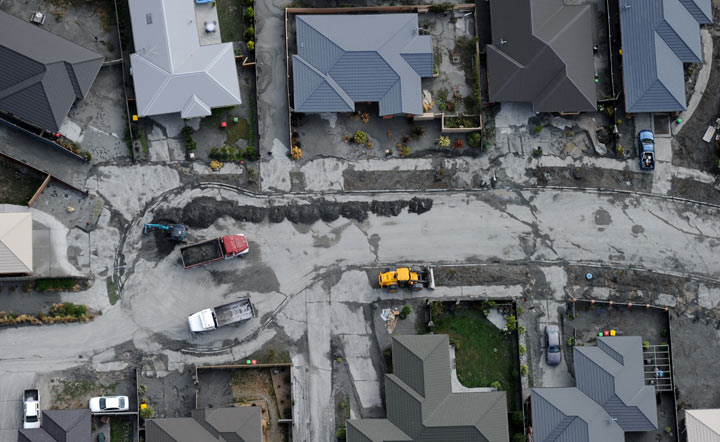TORONTO – The Insurance Bureau of Canada (IBC) has released a study that suggests Canadians are not prepared physically or financially for a major earthquake in British Columbia or in the Quebec City-Montreal-Ottawa region.

The research, conducted by risk modeling and consulting service AIR Worldwide and presented in Ottawa Tuesday morning, estimates economic loss in the tens of billions of dollars, and points to a lack of Canadian earthquake insurance.
IBC board saw the earthquakes and devastation in Chile, Haiti, New Zealand and Japan, and “were concerned our country wasn’t prepared for a major earthquake, and that maybe our industry wasn’t prepared,” said Gregor Robinson, IBC’s senior vice-president of policy, and chief economist.
IBC also wanted to look into risks associated with earthquakes: shake, tsunamis, liquefaction, fire following earthquakes and landslides, particularly on the west coast “Ring of Fire” region.
“Nearly every other country on the Ring of Fire has had a major earthquake in recent decades,” said Robinson. “We haven’t had a major one since 1700.”
Robinson said the last study of the impact of major earthquake was in 1992, and that there was no research “at all” of potential earthquakes in eastern Canada.
As a result, IBC asked consulting firm AIR Worldwide to select two scenarios: one in British Columbia and one in the Quebec City-Montreal-Ottawa corridor.
- Life in the forest: How Stanley Park’s longest resident survived a changing landscape
- ‘Love at first sight’: Snow leopard at Toronto Zoo pregnant for 1st time
- Carbon rebate labelling in bank deposits fuelling confusion, minister says
- Buzz kill? Gen Z less interested in coffee than older Canadians, survey shows
Senior Vice-President of Research at AIR Worldwide Jay Guin presented the first scenario of a magnitude 9 earthquake in the region off the coast of Vancouver Island. He said that region is capable of generating large quakes, similar to the ones that occurred in Chile and Japan in 2011.
In that scenario, Guin said there would be significant levels of damage from ground shaking, and that this type of earthquake could also trigger tsunami, liquefaction and landslides. Guin explained the most intense shaking would be felt on the lower mainland but that the shaking would be felt all through the province.
He expected the city of Vancouver to be largely shielded from a tsunami, but that Richmond would be extremely vulnerable to liquefaction (when sandy soils saturated in water behave like quicksand due to shaking caused by earthquakes).
“In Christchurch, New Zealand in 2011, that’s what happened,” said Guin.
He put the total economic loss for the scenario at $75 billion, citing damage to infrastructure and buildings, and noting that a large portion is uninsured. He mentioned indirect consequences such as airport or port damage.
“For this scenario, the ground shaking is still the primary driver of losses,” said Guin. “But liquefaction and tsunami are non-trivial losses as well.”
The second scenario involved a magnitude 7.1 earthquake at a shallow depth on the St. Lawrence River about 100 kilometres northeast of Quebec City.
Guin said this scenario is different because of the “geologically very old region” where old infrastructure would see much damage. The quake would be powerful enough that a large part of Quebec and Ontario would feel the ground shaking, from Toronto to Boston.
“We do not expect a lot of damage due to other sub-perils,” said Guin. “No tsunami in this peril…and landslide, liquefaction are limited compared to the western scenario.”
His research pegs the total economic loss for the scenario at $61 billion – mostly due to property damage- and said given the current insurance conditions and market in this region, “the insured losses out of the $61 billion to be only $12 billion.”
Guin said the way to interpret these scenarios is with a chance of occurring 1 in 500 or 0.2 per cent probability in any given year.
“It’s not a matter of if these scenarios will happen, but rather when they will happen,” he said.
IBC’s President and CEO Don Forgeron said his report is “not about selling earthquake insurance.”
“It’s about fostering a multi-pronged culture of preparedness for a risk that should have us all running just a little bit scared.”
Forgeron pointed to the need for public infrastructure designed specifically for earthquakes, and championed British Columbia for their building code and retrofit initiatives, as well as their emergency drills.
However, he said 55 per cent of British Columbians and 96 per cent of Quebecers have no earthquake coverage, suggesting a “consumer denial that a major earthquake is going to happen.”
IBC acknowledged their report raised “more questions than answers” and called for collaborative action from government, insurers and consumers to ensure “physical and financial preparedness.”
The AIR Worldwide study began in May 2012, took more than a year to complete and cost more than $1 million.



Comments